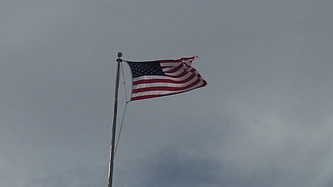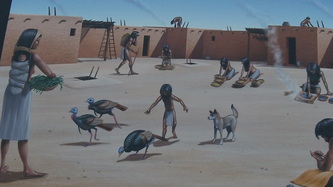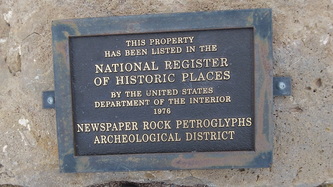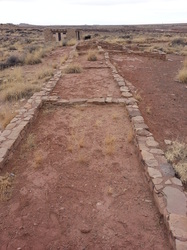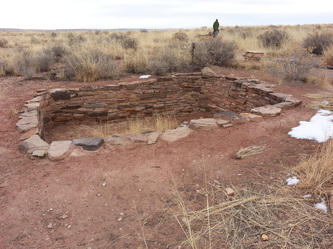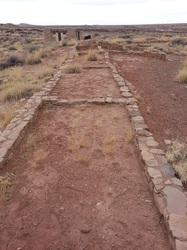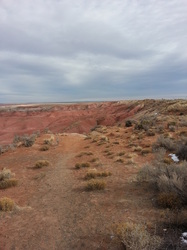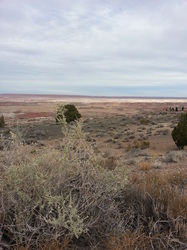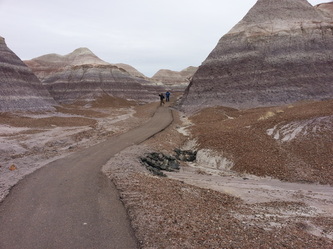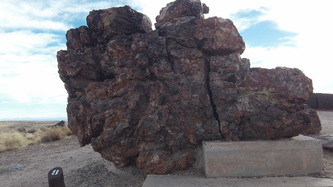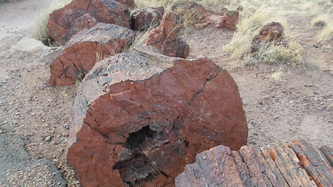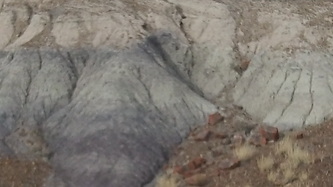Here people from 1200 AD, Pueblo people, used the dirt and rock to judge when it was time to plant corn to eat. This is called the summer solstice. The sun at a particular time goes through a crack in the rocks, hits at a particular point on another rock. This tells the Indian when to plant.
The Painted Desert and The Petrified Forest are located on the Chinele Formation. The Chinele Formation is a land having many colors. The Chinele Formation has very soft sedimentary rock. Within the layers of rock the colors are made up of:
1) minerals = red..... Red is iron
2) decompsed or decayed animals and plants=grey
3) volcanic ash = white
the Painted Desert
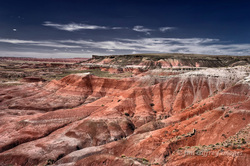
The Painted Desert has been described by Rose Houk, author of The Painted Desert, as a "land of light and shadow." The reason she described The Painted Desert as a "land of light and shadow" is because what a person sees depends on three things:
1) When? the time of day, morning, afternoon or sunset
The colors are brighter either in the early morning
or at sunset.
2) If the desert is wet or dry.
The colors are brighter after a rain.
3) If there are both shadows and sunshine.
The contrast between dark and bright makes the
colors brighter.
Each season, depending on time of day, rain or sun, and contrast of the shadows as many as 168 different colors have been seen on The Chinele Formation.
1) When? the time of day, morning, afternoon or sunset
The colors are brighter either in the early morning
or at sunset.
2) If the desert is wet or dry.
The colors are brighter after a rain.
3) If there are both shadows and sunshine.
The contrast between dark and bright makes the
colors brighter.
Each season, depending on time of day, rain or sun, and contrast of the shadows as many as 168 different colors have been seen on The Chinele Formation.
When or what time of day do you think these pictures were taken. Or, when did we take the pictures; morning, afternoon or sunset??
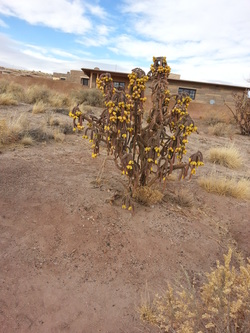
What is a desert?
1) A desert gets eight (8) inches, or less, or rain each year.
2) A desert has strong winds. At times, the wind is blowing so hard there are walls of blown sand. The walls of blown sand are so thick a person can't see through the walls of sand.
3) During the winter the desert changes from many colors to white. It can be very cold with lots of snow.
1) A desert gets eight (8) inches, or less, or rain each year.
2) A desert has strong winds. At times, the wind is blowing so hard there are walls of blown sand. The walls of blown sand are so thick a person can't see through the walls of sand.
3) During the winter the desert changes from many colors to white. It can be very cold with lots of snow.
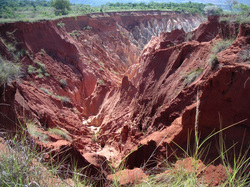
What is erosion? Erosion is a process which shapes the land. The Painted Desert and the Petrified Forest erode through the process of water and wind acting on them. When it rains it pours on the Chenile Formantion. The summer months are the rainy season. During the rainy season the slopes loose one quarter (1/4) inch of sand. When the sand washes away the slopes become smaller. Some of this sand washes into the Colorado River. The Little Colorado River and The Big Colorado River run through to the Grand Canyon. Sand and silt at the bottom of the Little Colorado River flows into the Big Colorado River. When you visit the Grand Canyon National Park with the Colorado River flowing through it you can see sand and silt from the Painted Desert and Petrified Forest..
Press the red button for video on the meaning of water and wind erosion.
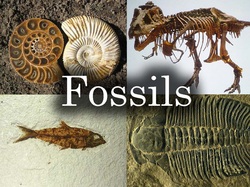
What is a fossil? The Chenile has a variety of fossils buried under the surface. Dinosaurs long ago, 220 to 225 million years ago, roamed The Chenile. Plants, insects, snails and crabfish lived at the same time as the dinosaurs. After they died, the winds would blow and water flowed covering plants, dinosaurs and water life. And, after millions of years we have fossils.
As you learn about the Petrified Forest see if you can answer this question............
Do the Painted Desert and The Petrified Forest
share the same ecological system?
The Petrified Forest
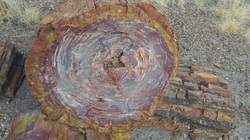
The Petrified Forest sits on the Chenile Formation and is a desert. Do you think there is erosion in The Petrified Forest? Do you think the tree trunk pictured is a fossil? The anwer is "yes" to both questions.
Petrified means (=) The trunk of the tree has been preserved or saved by changing from its cells to minerals.
A fossil can be anything- a plant, animal or micororganism - that has been preserved.
Petrified means (=) The trunk of the tree has been preserved or saved by changing from its cells to minerals.
A fossil can be anything- a plant, animal or micororganism - that has been preserved.
Petrified Forest
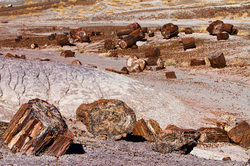
Do you see any live trees? This forest lived 200 to 225 million years ago. You would see dinosaurs roaming among the trees long ago. The trees changed to fossils differently than the fossil found in the Painted Desert. The Painted Desert fossils were preserved as the waters and wind burried the bones, seeds, leaves, snails and other water life.
Minerals, like iron, preserved these trees. These tree trunks are so hard. You cannot cut them. When you see these trees up close they look like glass.
Minerals, like iron, preserved these trees. These tree trunks are so hard. You cannot cut them. When you see these trees up close they look like glass.
